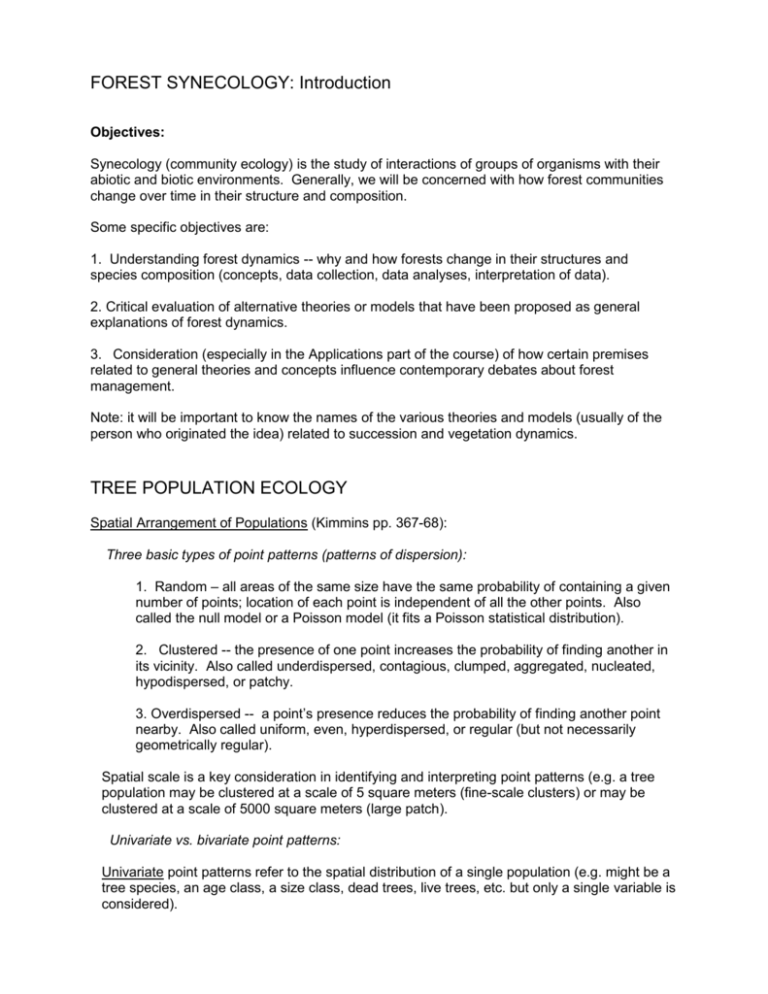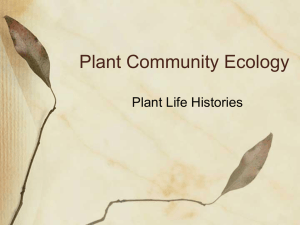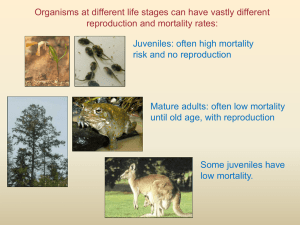11-Population Ecology
advertisement

FOREST SYNECOLOGY: Introduction Objectives: Synecology (community ecology) is the study of interactions of groups of organisms with their abiotic and biotic environments. Generally, we will be concerned with how forest communities change over time in their structure and composition. Some specific objectives are: 1. Understanding forest dynamics -- why and how forests change in their structures and species composition (concepts, data collection, data analyses, interpretation of data). 2. Critical evaluation of alternative theories or models that have been proposed as general explanations of forest dynamics. 3. Consideration (especially in the Applications part of the course) of how certain premises related to general theories and concepts influence contemporary debates about forest management. Note: it will be important to know the names of the various theories and models (usually of the person who originated the idea) related to succession and vegetation dynamics. TREE POPULATION ECOLOGY Spatial Arrangement of Populations (Kimmins pp. 367-68): Three basic types of point patterns (patterns of dispersion): 1. Random – all areas of the same size have the same probability of containing a given number of points; location of each point is independent of all the other points. Also called the null model or a Poisson model (it fits a Poisson statistical distribution). 2. Clustered -- the presence of one point increases the probability of finding another in its vicinity. Also called underdispersed, contagious, clumped, aggregated, nucleated, hypodispersed, or patchy. 3. Overdispersed -- a point’s presence reduces the probability of finding another point nearby. Also called uniform, even, hyperdispersed, or regular (but not necessarily geometrically regular). Spatial scale is a key consideration in identifying and interpreting point patterns (e.g. a tree population may be clustered at a scale of 5 square meters (fine-scale clusters) or may be clustered at a scale of 5000 square meters (large patch). Univariate vs. bivariate point patterns: Univariate point patterns refer to the spatial distribution of a single population (e.g. might be a tree species, an age class, a size class, dead trees, live trees, etc. but only a single variable is considered). Bivariate point patterns refer to the spatial distributions of two variables (usually two types of populations). For bivariate point patterns we often want to know if the two variables (e.g. standing dead trees vs. seedlings of tree species) tend to cluster or “co-occur” at some spatial scale. Thus, we determine if they are spatially associated. Spatial association describes the tendency of the plants of different populations to be found in close proximity more often than expected (positive association, co-occurrence, joint occurrence) or less often than expected (negative association, repulsion). A simple classification of causal factors of spatial patterns: A. Morphological causes– Vegetative reproduction Poor dispersion of heavy disseminules Caching of disseminules B. Community causes (biotic interactions and disturbance) Intra-specific competition (overdispersed patterns for a single species) Inter-specific competition (repulsion or negative association of two species) Density-dependent mortality (self-thinning) results in overdispersion Mortality caused by host-specific pests (repulsion of parent and offspring, hyperdispersion) Positive biotic interactions (nurse shrubs result in co-occurrence of species, facilitation and “nucleation” around colonizing plants) Animal caused patterns (e.g., termite mounds may result in patchy plant distributions) Fine-scale treefall gaps (patch size of juvenile populations may be the size of a canopy gap) Stand-level replacement (catastrophic regeneration mode) may result in large patches Population Growth (Kimmins pp. 373-376) What is the difference between geometric (exponential) growth and logistic growth curve? In qualitative terms, what do the variables “r” and “k” mean in the geometric and logistic equations of population growth? Plant Population Ecology What is the unit of a population? Genet = a unit (plant) in the population arising from a seed from sexual reproduction. Ramet = a unit (plant) in the population arising from vegetative reproduction; ramets (even after being separated from parent plants) are genetically identical. Group of ramets from a single parent = a clone. Population concept is simple for discrete individuals, but complicated for clones (e.g. aspen). Most discussions and methods related to tree population ecology assume that the persistence of the tree population depends on seed production, seedling establishment, growth to maturity, and reproduction from seed. However, vegetative reproduction is important for many tree species and can lead to long-term persistence of the population. Tree regeneration is a process, and it should not be assumed that presence of juveniles (e.g. seedlings) necessarily means that regeneration will be successful. 1. Tree seedling recruitment/establishment a. Seed rain = production of seed and dispersion of seed to the site. Seed production can be highly variable from year to year. b. Seed bank = seed pool (living but ungerminated seeds) that may last only one season or much longer as buried viable seed c. Bud bank = potential growing points on stem, root crown, roots, lignotubers or rhizomes that are highly important in vegetative reproduction (e.g. coastal redwood, Nothofagus antarctica, etc.) d. Seedling bank = shade-tolerant or semi-shade-tolerant seedlings that potentially can survive and grow to maturity, especially when “released” from suppression. In practice this also includes vegetative reproduction such as root suckers. Foresters refer to this as “advance regeneration.” e. Seedling recruitment and “safe sites” = microsites suitable for germination and seedling survival. Environment acts as a “filter;” therefore, absence of seedlings may reflect lack of seed rain or lack of “safe sites”. The concept of regeneration niche (P. Grubb) refers to all the requirements for successful tree reproduction (e.g. seed production, dispersal, germination, survival of seedlings, etc.). Regeneration niche stresses the importance of micro-site conditions for seedling survival in contrast to the general niche concept (pp. 427-428 in Kimmins) which for mature trees often is not discriminating between tree species (e.g. Engelmann spruce and subalpine fir). 2. Seedling survival/tree population demography Cohort = all the population units that originate in the same time period. Time period may be a single year or defined to be multiple years (the latter is typical in the study of the demography of long-lived trees). Population Age Structure A. Cohort life table = a “fixed” cohort life table (a dynamic life table). Recruitment rate and mortality rate can be measured by monitoring cohorts in long-term studies. Result is a cohort life table. Age (x) refers to a time interval (e.g., number of days, one year, multiple years). “Age-specific mortality rate” = qx = the % of the population dying during a particular time interval. The number of individuals that die during the age interval = dx. The number surviving to the beginning of the next age interval = Nx. The proportion of the population surviving at the beginning of the age interval is the survivorship (lx). B. Survivorship curves Deevey’s (1947) classification is: Type I: low mortality, then collapse of the population. Type II: constant percentage of survivors dies per unit of time (represented by a negative exponential model). Type III: high death rate of juveniles followed by lower mortality rate of mature organisms (represented by a power curve model). Note: Kimmins in Fig. 14.8 has added a new Type II curve (constant absolute number of deaths); Deevey’s Type II = Kimmins’ Type III (constant %) and Deevey’s Type III = Kimmins’ Type IV (declining % mortality). Ignore Kimmins’ classification. See Veblen 1992 pages 158-161 for an explanation of the application of exponential and power function models to the Deevey’s Type II and Type III survivorship curves, respectively. Stable age distribution = constant shape to the survivorship curve (but total number of individuals may vary); the population may be steadily declining or increasing. Constant population size means natality = mortality, and has a stationary age distribution (i.e., neither growing nor declining). This is equivalent to the survivorship curve for a population that is neither growing nor decreasing and that is at equilibrium with its environment. C. Static life tables (stationary age distribution; instantaneous life table) These are “time-specific life tables” because they are based on determining plant ages at one point in time rather than following cohorts. Tree population age structures are sometimes assumed to be true cohort life tables from which survivorship curves can be constructed and agespecific mortality rates derived. What are the assumptions required to derive tree mortality rates from static age structure data? Density-Independent Regulation (mortality) and Density-Dependent Regulation Conceptual basis of the so-called -3/2 thinning rule is that any site has a maximum plant biomass-carrying capacity. Thus, as the as the tree population approaches this limit, individual tree growth can continue only if the number of individuals is reduced. Over time, as mean tree size increases, the number of individual trees decreases. The -3/2 thinning rule was proposed as a general quantitative relationship of mean tree size and stand density that might guide forest management. However, there is too much variation in the slope of the self-thinning line related to species’ differences, understory conditions, and site variability, etc. to support the claim that this quantitative rule applies to all situations. Oliver’s simple model of stand development. Stand initiation = early development of a cohort before stand closure; new recruitment may occur and density-independent tree mortality may occur. Stem exclusion = following canopy closure, additional recruitment ceases. Density-dependent tree mortality caused by competition results in self-thinning; typically understories are sparse. Understory reinitiation = self-thinning and fall of larger trees creates higher light levels in the understory; understory vegetation and tree seedling populations develop. Old growth = canopy gaps created by death of large trees are sufficient for juvenile trees to grow into the canopy, resulting in a mixed-age and multi-canopy stand, usually with snags (standing dead trees). Continuation of the old growth phase eventually results in the replacement of the initial cohort by trees that established during the old-growth phase resulting in so-called “true old growth” (i.e. no remnant trees from the cohort that established after the stand-initiating disturbance). Selection patterns: r- and K-selection Are there character syndromes that allow predictions of how a tree species will respond to predictability of resource availability and disturbance? See Kimmins’ Table 14-6 on features of r- and K-selection. r-selection emphasizes rapid (geometric) population growth instead of competitive ability; typical of patchy, unstable and unpredictable habitats (disturbance). Competitive ability is low. Synonyms: opportunists, pioneers, weedy spp. Likely traits for trees include effective dispersal, rapid growth of individual and of the population, reproduction at an early age, ability to colonize open site, short life-span, and poor resistance to pests and pathogens. K-selection emphasizes high competitive ability rather than rapid population growth; typical of stable, uniform and predictable habitats (less disturbance). Synonyms: equilibrium spp., climax spp. Likely traits for trees include slow dispersal, slow growth of individual and population, later reproductive maturity, poor colonizing ability, long life span, strong vegetative reproduction, and strong resistance to pests and pathogens. r- and K-selection often is applied to distinguish among life forms (e.g. trees versus annual plants), but also can be applied just to the tree life form. A tree species will sometimes show features of both r- and K-selection (e.g. produce abundant light seeds but also be able to root sucker). These “strategies” are useful ways of describing some character syndromes, but don’t expect all tree species to fit neatly into one or the other selection category.








